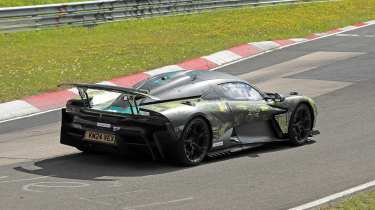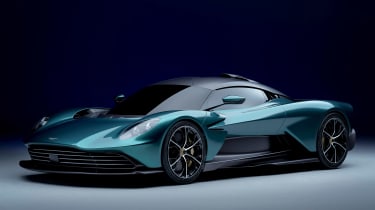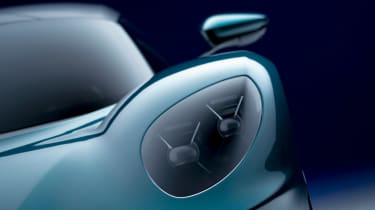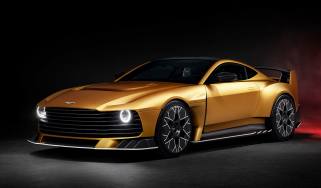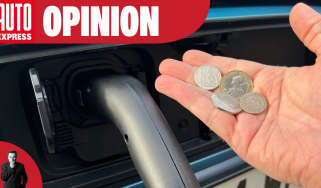New Aston Martin Valhalla: testing extends to the Nurburgring
British sports car-marker’s upcoming mid-engined supercar is packed with F1 technology
We’ve been waiting a while for the Aston Martin Valhalla, but the brand’s flagship is almost ready to launch – five years on from the initial concept’s reveal in 2019. These latest images show the British supercar taking on the Nurburgring, confirming plenty of the styling tweaks we saw at Silverstone late last year.
Aston Martin has already targeted a Nurburgring lap time of around 6 mins 30 seconds, which would make it the fastest production car to lap the ‘ring by beating the current Mercedes-AMG One record holder.
That record would be quite the statement for what would be the first series-production mid-engined road car in Aston’s 108-year history. The maker has also confirmed the car will enter production in 2024, with a limited run of 999 models.
As we’ve previously seen, the production car will look notably different to the concept car with more aggressive aerodynamics and technological know-how from Aston Martin’s F1 team. Still badged as a ‘prototype’, we can see the lip spoiler has been adjusted, and there’s a redesigned grille, too. The headlights have a new light signature that is more akin to that found on the Aston Martin DBS, and the wing mirrors sit lower than before.
The dramatic vent behind the front wheel stays, but the side skirts have been altered and the lower vent ahead of the rear wheels looks different. We can still make out a subtle crease in the roof to allow air to funnel into the overhead air intake. The prototype car sports a set of plastic side windows with racecar-like sliders; we expect the production car to come with electric windows instead.
Aston Martin originally looked at relying on the car’s underbody airflow to deliver the necessary aerodynamic grip, but now we can see that the huge diffuser is being combined with a much larger rear spoiler than before. Active aerodynamics are set to feature on the Valhalla, so it’s likely that the spoiler will be movable, depending on the driving mode. We can see from these latest images that the rear wing offers plenty of manual adjustment.
Something that was carefully omitted from Aston Martin’s official Silverstone testing pictures was a picture of the rear end and here we can see an odd set of exhaust tips. There are top-exit exhausts like the concept’s, but strangely, there’s another pair of tips within the diffuser. Having both is unlikely, so we’ll have to wait and see which layout Aston Martin goes for.
Aston Martin Valhalla: powertrain, performance and range
With hybrid power on hand, the Valhalla “is at the forefront of Aston Martin’s transition from internal combustion to hybrid to full electrification”, according to the British brand. As Auto Express recently reported, the Valhalla concept’s in-house V6 has been scrapped in favour of what Aston describes as a bespoke 4.0-litre twin-turbo V8 engine with a flat-plane crankshaft. The new engine revs to 7,200rpm and is a similar unit first seen on the Mercedes-AMG GT Black Series in 2020.
It’s joined by a pair of electric motors - one on the front axle and one on the rear - Aston Martin initially claimed a total output of 937bhp for the hybrid system, but this has now increased to 1,003bhp - far surpassing the 805bhp output of the new plug-in hybrid Mercedes-AMG GT 63 S E Performance (which should use the same 4.0-litre V8). The engine is mated to an all-new eight-speed dual-clutch automatic transmission (another first for Aston, which will be used on future models) sending power to the rear wheels through an electronically controlled limited-slip differential.
The car’s rear electric motor and V8 petrol unit can run separate gears in the new transmission, which allows for a maximum torque output of 1,000Nm, according to Aston Martin. Thanks to the added traction the Valhalla’s four-wheel drive capability brings, the 0-62mph sprint takes a claimed 2.5 seconds, while the car will hit a top speed of 217mph.
In zero-emissions EV mode the car only uses its front-mounted electric motor and can hit a top speed of 80mph, while electric-only range stands at a claimed nine miles. The Valhalla also boasts an e-reverse gear, using electricity only when reversing to help save weight in the transmission.
In other modes, power from the 400V electrical system is split between both electric drive units and varies depending on driving conditions. However, up to 100 per cent of the electrical power available can be sent to the rear-mounted motor under certain circumstances. Aston Martin hasn’t said what battery will be used in the plug-in hybrid system, but expect it to be on the smaller end of the scale to keep weight down.
Aston Martin Valhalla: chassis, aerodynamics and design
The Valhalla’s new chassis is as advanced as its powertrain, constructed from carbon fibre for maximum stiffness and as low a kerbweight as possible; Aston is targeting a dry weight of less than 1,550kg for the Valhalla.
Aston Martin claims the Valhalla “significantly benefited” from the knowledge of its Formula One team, although we don't know to what end Aston’s F1 operation is involved in the Valhalla’s development.
We do know the Valhalla will employ F1-style double wishbone pushrod suspension features at the front with inboard springs and dampers and is joined by a multi-link layout at the rear. The suspension set-up uses what Aston calls “Multimatic Variable Spring Rates and Adaptive Spool Valve Damper units” giving adaptive capability to balance ride comfort and handling performance on road and track.
The power steering is electrically assisted, while the Valhalla’s Carbon Ceramic Matrix brakes use brake-by-wire technology, just as in F1. They sit behind 20-inch alloy wheels at the front and 21-inch rims at the rear, which come fitted with bespoke Michelin tyres.
There is a Track mode for the chassis which firms up the dampers and drops the ride height “dramatically” according to the brand, working with the Valhalla’s aerodynamic package to help improve downforce and therefore grip. The British brand claims its new supercar produces 600kg of downforce at 150mph.
Active aerodynamics also feature, inspired by the brand’s Valkyrie hypercar (itself using many technologies derived from F1), with adjustable front surfaces and a deployable rear wing. A central roof scoop between the dihedral doors’ hinges feeds air into the V8’s airbox.
According to Aston Martin’s Chief Creative Officer, Marek Reichman, “When we created the Valhalla concept we were keen to emphasise the design legacy of the Aston Martin Valkyrie and that intent remains unchanged, but the execution has evolved considerably in order to reach production of this all-new car.
“Though the legacy of Valkyrie is clear, Valhalla is now a more mature, fully resolved piece of design. One which combines the pure aerodynamic function you would expect from a marque competing in Formula One together with the beautiful form, striking proportions and exemplary detailing for which Aston Martin is renowned.”
Aston Martin Valhalla: interior and technology
Aston Martin hasn’t yet revealed any images of the Valhalla’s interior, but it has confirmed that the new supercar will offer more cockpit room than the more cramped and more performance-focused Valkyrie.
The cabin will still be focused around the driver and will feature a new central touchscreen display that integrates Apple CarPlay and Android Auto connectivity. The seats won’t be adjustable - instead, the wheels and pedals will move to ensure the driver can find their optimum position. Like the Valkyrie - and an F1 car - the Valhalla’s footwells will be raised up higher than normal, which helps to lower frontal area and boost aerodynamic performance.
Standard-fit equipment includes adaptive matrix LED headlights, dual-zone air-conditioning and driver assistance systems including autonomous emergency braking, forward collision warning, active cruise control, blind-spot monitoring and a rear-view camera with an around-view optional extra available.
Commenting on the unveiling of the Valhalla back in 2021, Executive Chairman Lawrence Stroll said: “Aston Martin’s first series production mid-engined supercar, Valhalla is a truly transformational moment for this ultra-luxury brand. The launch of Valhalla demonstrates Aston Martin’s commitment to building a range of exceptional mid-engined driver focused cars, a crucial next stage in the expansion of our product line-up.
“It also seemed fitting to unveil this stunning track-biased supercar at the home of motorsport and the home of the Aston Martin Cognizant Formula One Team and marks Aston Martin’s return to the British Grand Prix for the first time in over 60 years, a true milestone.”
Pricing for the Valhalla has not yet been announced, but given the car’s claimed performance expect it to compete with the 1,001bhp Lamborghini Revuelto plug-in hybrid, which costs around the £430,000 mark.
Now read our list of the best hypercars in the world...



